Yesterday I posted Freiburg, Germany: City of the Future. Part I: Keeping What Works (a photo diary)— the first in a two-part series about Freiburg, a model for urban sustainability and innovative city planning located at the edge of the black forest in the south-western corner of Germany. As part of a trip to my native Germany this summer I was doing a photo essay and an interview with Freiburg’s Head of Urban Planning, Professor Wulf Daseking, and came away with so much extra info, pics and snippets to warrant a more in-depth look at Germany’s Environmental Capital.
As Part I showed, Freiburg’s success in becoming one of the most livable urban environments in the world dates back to a planning decision after World War II to reconstruct the city’s destroyed historic center in adherence to its previous medieval walkable, multiple use layout. However, what earned the city the Academy of Urbanism’s 2010 European City of the Year award is not just a deep respect for its cultural and architectural roots but an irreverent flair for bold and unconventional planning decisions.
Today’s post will be about these creative ways in which Professor Daseking and his planning team were able to accommodate population growth within its coveted city limits over the last 25 years and avoid the trappings of urban sprawl. Using a former brownfield site and military base to realize their vision of creating community-conceived, ecologically integrated, and socially diverse neighborhoods, they developed two new suburbs, only a 15 minute tram ride from downtown Freiburg: Rieselfeld and Vauban, two thriving eco-villages that make car-free and high density living easy, fun, and a matter of civic pride for its residents.
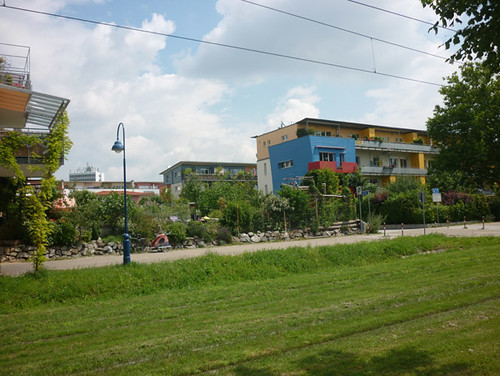
View over the tram tracks of the main road in Freiburg’s Vauban neighborhood.
While each of the neighborhoods have their own unique history and design accents, I feel like they’re both similar in essence and nature, so I’m going to mix and match images and impressions here to tell the story.

view of Rieselfeldallee, the main drag on the former brownfield site
The story of Rieselfeld and Vauban has to be viewed within the context of the recently published the Freiburg Charter for Sustainable Urbanism, documenting Freiburg’s experience in building a compact, sustainable city and laying out twelve universal principles that put together would be important milestones on any city’s master plan.
The 12 Guiding Principles from The Freiburg Charter for Sustainable Urbanism
Spatial
I Diversity, Safety & Tolerance
II City of Neighborhoods
III City of Short Distances
Iv Public Transport & DensityContent
v Education, Science & Culture
vI Industry & Jobs
vII Nature & Environment
vIII Design QualityProcess
IX Long-Term Vision
X Communication & Participation
XI Reliability, Obligation, Fairness
XII Co-operation & Partnership
I had heard and read a lot about Vauban and Rieselfeld, everything from being brave utopian eco visions to drab and oppressive subdivisions reminiscent of former Eastern bloc developments. So my first goal before studying up on any of the how’s and why’s was to get a feel for them, so I hopped on the tram to take the 15-minute (Vauban) and 20-minute (Rieselfeld) rides from downtown to catch the vibe. I have to say it was love at first sight…



When you first roll into these neighborhoods it becomes very clear that they were conceived with public transit as the central transportation axis.
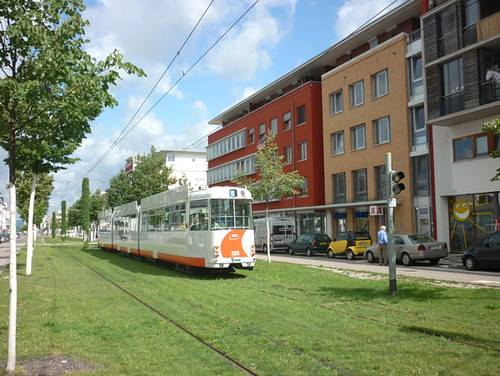
In fact, the trains themselves carry the community’s modus operandi on its banners:


left: “If you’re good on foot, you’re good for the climate.”
right: “Brains turned on: Engine turned off. For zero CO2 on short trips.”
What’s remarkable about Rieselfeld and Vauban is that the community, the people and families who live there, were closely engaged in the development process at every level, in collaboration with the city and the planning department. In the aftermath of Chernobyl, many folks wanted to be part of a different way of life, one that would conserve energy and reduce their collective impact on the planet’s resources.
Professor Daseking recalls:
We sat together for many months in open discussion. From technical drafters to structural engineers, everyone was welcome to chime in about the future of Vauban. To take up where we left off with Rieselfeld we were drawing up a completely car-free district, which of course didn’t quite turn out that way, but we reduced car usage as much as possible. Consider that for every 1000 people in Germany there are 500-550 cars. In Freiburg it’s 430 cars, and in Vauban it’s below 100. What you have to realize is that you have to create incentives for people to go without car. This may not be possible in every city, but the potential was there in Freiburg.
The incentives, of course, are that the way these eco-villages are designed, with everything close by, safe walking and biking paths everywhere and quick and easy access to public transit, you don’t really need a car. Driving a car is quite inconvenient, as there are only two places to park in Vauban: In the Sun Ship parking garage and along the main road, Vauban Allee. And owning one is even worse, as a annual spot in the Sun Ship sets you back 18,000 Euro.
Speaking of the Sun Ship:
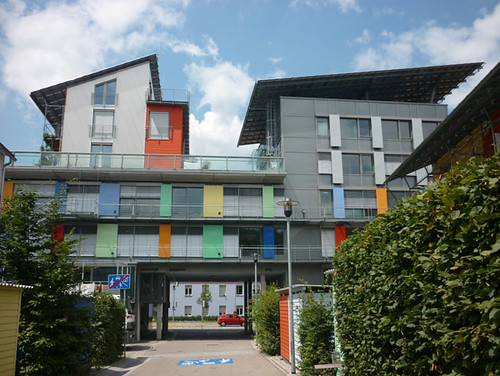
The ‘Sun Ship’ forms one of the main axes in Vauban and is a mixed-use building with bicycle and car parking, a supermarket, local shopping facilities, business and enterprise units, apartments and solar-plus houses that generate surplus energy to be sold back to the grid at a profit for residents.
The thing about cars is not just that they’re huge energy wasters and polluters carrying around thousands of pounds of steel, especially for short trips, but they take up a lot of space. We often don’t realize how much of our space they actually occupy and what we could be doing with that space until they’re gone. And Vauban is one of the few urban places in the world where we can actually see what it looks and feels like.

We approached this within the context of building an entirely new district, a city of short distances, commercial outlets nearby, tram line running right down the middle of it, good shopping centers, public institutions, kindergartens, schools, etc. Another goal was to keep roads small and narrow, keep them primarily as access roads with limited parking time, keep parking garages off site rather than at each building. You can drop off your grandmother or shopping bag in your car but you can’t leave your car in the street because the street belongs to the children to play.
That’s why you see these signs everywhere:

Traffic-Calmed Area
Walking Speed Only
Pedestrians May Use the Street in its Full Width
Childs Play is Allowed Everywhere
Parking in Marked Areas Only
All Traffic Participants Must Respect Each Other
all kinds of places for kids to play…

However, the reason Vauban and Rieselfeld have been so wildly successful is not because of the things you can’t do, but because of what you can. There are those aforementioned public institutions…

Youth, Media and Community Center in the heart of Rieselfeld. Named “The Glass House” by residents, the center was completed in 2003, providing a community meeting space for educational opportunities and cultural exchange.

Alfred-Döblin-Platz in Vauban. The solar-paneled officers’ casino of the former French military base now houses a cultural arts center and restaurant.
excellent and cool-looking schools…



Schoolyard and gym at Clara Grunwald Elementary School in Rieselfeld, a public school with Montessori-trained teachers. The imaginative ecological design meets not only energy-efficiency and low-carbon emission standards but creates an inspiring and attractive learning environment.
…and a church like no other

Santa Maria Magdalena Church that houses both Catholics and Protestants, with a movable wall that can be rolled back on giant casters to create a single dual-faith church.
Of course, it wouldn’t be an eco-village without easy access to nature and green spaces everywhere…

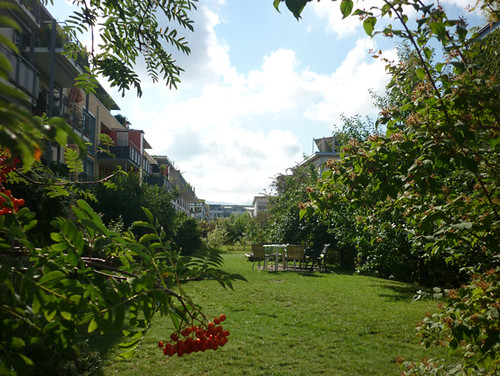
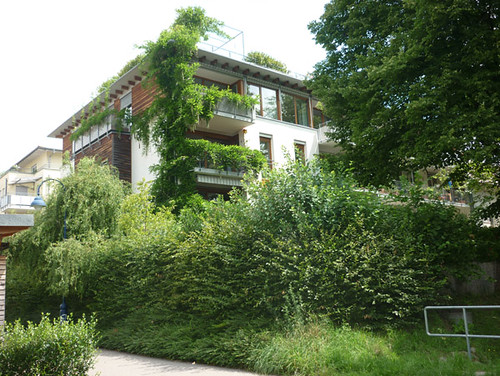
I think what really makes Vauban and Rieselfeld such realistic eco-villages rather than eco-topias is that it’s not just a fancy green palace for a few well-heeled folks, but an actual affordable housing development where young, low-income families can afford to buy a home. By keeping a strong presence of the public sector that is able to commission small development parcels to groups of people who are going to live there rather than to developers who have no long term interest in the place, the city was able to attract a diverse population that holds a direct stake in the long-term success of these experiments.


What’s funny though is that this is not going far enough for some. In a city that 43% voted Green in the most recent state election and where the Green Party is mainstream and status quo, there’s still a pretty good number of folks who maintain that as long as the system is capitalistic you’re basically just greenwashing. Kommando Rhino is was a circled wagon settlement of anarchists that until last week occupied a former parking lot right at the entry to Vauban…

with messages like these:

Green Capitalism is a Lie
Take a peek inside:

pretty cozy, huh?

The fact that the Rhino settlement was allowed to stay there for two years I find rather refreshing. Professor Daseking told me that the occupants had actually been part of the public debate on what to do with the space, but when the decision was made to build a hotel tailored to staff and residents with special needs, they didn’t want to leave. Last Wednesday night the police closed down Rhino, and the approximately 150 occupants ceded the space, noisily and with some smoke, but mostly peacefully. I think it’s cool that the city and the permanent residents of Vauban had been very patient with and tolerant of the squatters over the last two years, a tribute to a democracy in action mentality that tries to respect all its diverse voices. And in many ways it served a higher purpose, as the new hotel will be a beacon of ecological design and social justice.

“Energy Autonomy – Cities are becoming climate neutral.” Signs seen around town pointing out that 40% of energy is used (and wasted) in buildings and how new designs are making buildings energy-plus, meaning they actually produce energy.
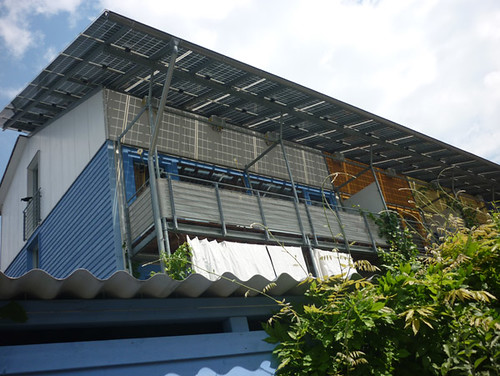

And that’s what it comes down to: People. To realize a lean, ecologically-attuned city with a small footprint that is not just a theoretical model but a living breathing organism, we have to listen to each other, educate ourselves, and find our shared values.
I’ll once again close with the final quote from my interview with Professor Daseking, because I think it quite beautifully sums up what they have done and are still working toward in Vauban and Rieselfeld, and what for me rings as the motto for the City of the Future:
We have to redesign our inner cities with ecological principles in mind. Another pivotal issue will be to keep working towards social justice and economic parity. Fostering cultural diversity will be very important. And of course, education, you have to have an educated population for any of this to happen. Obviously, all these issues are interconnected, a diverse and educated populace with economic opportunity is the foundation of an ecologically balanced city. There’s a lot of work ahead for generations to come, and I’m excited about it.
o~O~o~O~o~O~o~O~o~O~o~O~o~O~o~O~o~O~o
All photos by Sven Eberlein
crossposted at Daily Kos
Part I:
Freiburg, Germany: City of the Future. Part I: Keeping What Works (a photo diary)
some useful links
Universal Principles for Creating a Sustainable City – an interview with Wulf Daseking
Smart Parking Policy Makes a Difference, Even in Livable Streets Utopias
Remarkable Rieselfeld









Great lessons to be learned.
I love this part:
I admire the beauty of the old buildings and while you would not necessarily want 13th century sewer systems, keeping true to the ways of the early residents of a city gives us important connections to our past.
When we walk the same path from the city center to the rivers edge that people hundreds of years ago did, something very special happens.
The comment above was meant for Part I. I obviously need training in Roman Numerals. 🙂
Key point:
Most people have a difficult time doing the right thing when it comes to energy usage and the environment. The more inconvenient it is to do the wrong thing, the better our chance of them doing the right thing.
My retirement goal is to live in an urban community where I do not need or want an automobile. Seeing the Freiburg photos and reading about their success gives me hope that in America we can put up a few of these ourselves.
You’re funny, JanF. And I thought you were an internet pro. 😉
Re. #1: I do think that sometimes looking back gives us the best information on how to move forward. Most functioning and beautiful things on this great earth have already been discovered by our ancestors, we just have to apply them to our modern reality.
Re #2: I think it’s critical to reach that threshold where driving a car becomes more inconvenient, expensive, annoying and frustrating than walking, biking or public transit. The thing is that in so many cases it IS already more inconvenient, but people don’t realize it because they haven’t tried it the other way. That said, we need to keep working on providing those incentives, whether it’s through better infrastructure for non-drivers or better education on all the benefits of walking or biking. I think it can be done in the US, and in many places people are working hard to get us there. I think it’s exciting to be part of the movement, and hopefully by the time we retire, there will be some fully matured sustainable towns to live in.
I’m having street sign and street use envy. I’m imagining what our neighborhood would sound like with these priorities:
• Walking Speed Only
• Pedestrians May Use the Street in its Full Width
• Childs Play is Allowed Everywhere
• Parking in Marked Areas Only
• All Traffic Participants Must Respect Each Other
You’d be able to hear the cats shuffling down the sidewalk… 😉
I want to move!
They would love you and your family there, Cori.
You always go to the heart of what’s important, Sven. I envy them their simpler lives. I love the Traffic-Calmed Area sign:
Walking Speed Only
Pedestrians May Use the Street in its Full Width
Childs Play is Allowed Everywhere
Parking in Marked Areas Only
All Traffic Participants Must Respect Each Other
May they spread around the world.
Yes, I love those two. Even though it’s a generic and boring traffic sign the message somehow stands out and rings much deeper. It’s as if the voice of God is speaking, isn’t it? As one of my favorite Robert Hunter lyrics says: “One in a while you can get shown the light
in the strangest of places if you look at it right.”
[…] decided against all conventional wisdom to keep its medieval walkable core intact after WWII and is now reshaping its suburbs into eco villages. The City of Vancouver decided to adopt ecocity principles into its […]
[…] In its current state, it isn’t quite ready yet to attract the young families and other long-term residents that can give it a cultural identity with all its natural recruiting powers. (One place where Masdar planners might look to for inspiration on how to get people excited about moving in is Freiburg, Germany, where the city paired up architects and committed residents to collaborate on the design of its plannned ecovillages Vauban and Rieselfeld.) […]
[…] In its current state, it isn’t quite ready yet to attract the young families and other long-term residents that can give it a cultural identity with all its natural recruiting powers. (One place where Masdar planners might look to for inspiration on how to get people excited about moving in is Freiburg, Germany, where the city paired up architects and committed residents to collaborate on the design of its plannned ecovillages Vauban and Rieselfeld.) […]
[…] In its current state, it isn't quite ready yet to attract the young families and other long-term residents that can give it a cultural identity with all its natural recruiting powers. (One place where Masdar planners might look to for inspiration on how to get people excited about moving in is Freiburg, Germany, where the city paired up architects and committed residents to collaborate on the design of its planned ecovillages Vauban and Rieselfeld.) […]